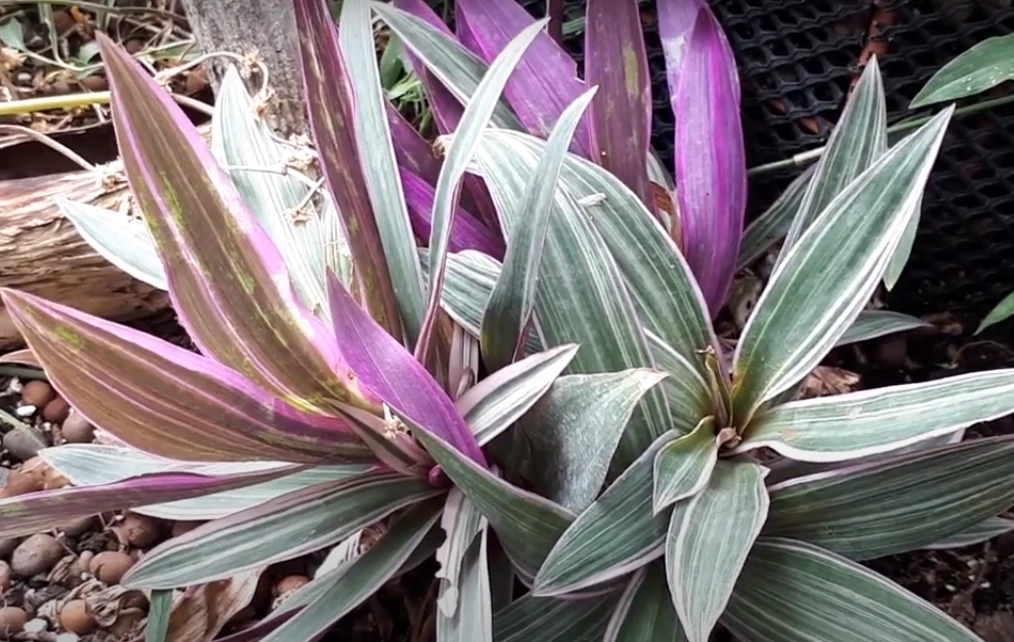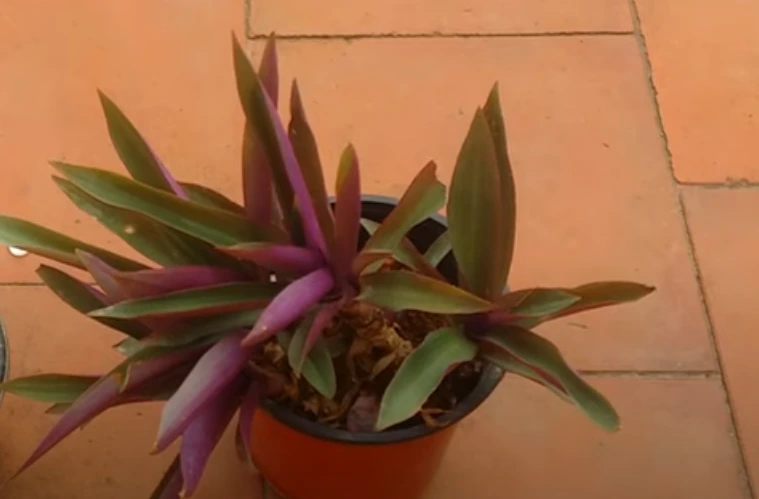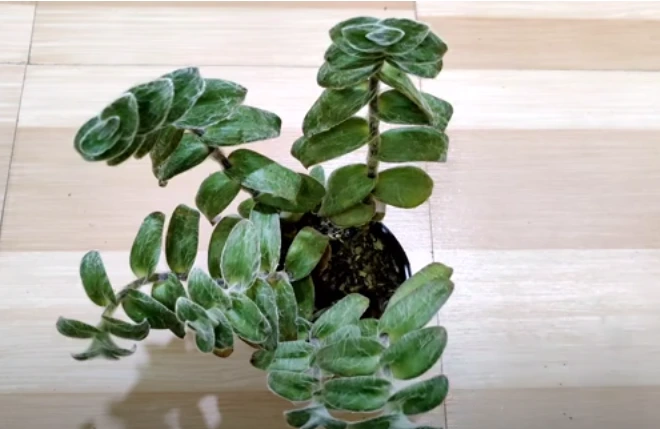Growing Gorgeous Tradescantia Spathacea Tricolor Plants
Hey plant lovers! Today I want to introduce you to a gorgeous houseplant called Tradescantia spathacea Tricolor, also known as the Moses-in-the-cradle. This easy-to-grow beauty is a member of the Commelinaceae spiderwort family and hails from the tropical forests of Belize, Guatemala, and southern Mexico.

Botanical Classification of Tradescantia Spathacea
The Moses-in-the-cradle plant has the following formal botanical classification:
Kingdom: Plantae (Plants)
Subkingdom: Tracheobionta (Vascular plants)
Superdivision: Spermatophyta (Seed plants)
Division: Magnoliophyta (Flowering plants)
Class: Liliopsida (Monocots)
Subclass: Commelinidae
Order: Commelinales
Family: Commelinaceae (Spiderwort family)
Genus: Tradescantia
Species: Tradescantia spathacea
Cultivar: ‘Tricolor’
To break it down in more everyday terms:
- Moses-in-the-cradle belongs to the Spiderwort family of plants, which tend to have long strappy leaves and small 3-petaled flowers.
- Within this family, it’s part of the Tradescantia genus. This genus contains many popular houseplants like the Wandering Jew plant and more.
- The specific species name is Tradescantia spathacea, referring to the clumps of rosettes it forms.
- And for the showy tricolored variety, we have the cultivar (cultivated variety) name Tricolor added on. This helps distinguish it from other varieties like Sitara’s Gold, Red Hill, etc.
Popular Varieties
There are a few different varieties of this gorgeous plant to choose from. Here are some quick highlights:
- ‘Tricolor’ – The classic variety with dark green, purple and metallic green leaves.
- ‘Sitara’s Gold’ – Stunning coppery-gold leaves with deep burgundy undersides.
- ‘Red Hill’ – Deep purple leaves that sometimes fade to green.
- ‘Canal Zone’ – Dark green leaves with striking hot pink undersides and white flowers.
No matter which variety you choose, Tradescantia spathacea Tricolor makes a vibrant, easy-care houseplant. Now let’s get into some growing tips!
Growing and Care Tips for Tradescantia Spathacea Tricolor
Now let’s dive into everything you’ll need to know to grow a happy, healthy Moses-in-the-cradle plant! From proper light and water to tips for troubleshooting problems, I’ll share the nitty gritty details.
First up, Tradescantia spathacea Tricolor definitely lean towards being drama queens (and kings!). Seriously, these beauties demand decent care and conditions to strut their stuff. But hey, high maintenance types often flaunt the best glam, am I right?
In all seriousness though, don’t let that scare you off if you’re a beginner! Just focus on understanding what makes this plant tick.

Giving Your Plant Proper Lighting
Let’s start with one of the most important things – lighting needs. All those splashy tricolored leaves aren’t just for show! Like most plants, Tradescantia spathacea depends on light to work its magic transforming water and nutrients into gorgeous growth.
Too little light equals a dull and leggy Moses-in-the-cradle. Meanwhile too much direct sun crisps those tender leaves to a brown, shriveled mess. No one wants that!
So what’s the sweet spot? Bright indirect sunlight is best! An east or west-facing window where your plant gets maybe 2-4 hours of gentle direct morning/evening rays. Supplement this with sheer backlighting during the intense midday period.
If you don’t have a good window spot, consider a grow light. This gives you total control over timing and intensity! Just watch leaf signs – vivid purple/green color, compact growth and perky sheen signal great lighting. Adjust if your Moses starts stretching upwards seeking more sun.
Watering Needs
Another essential piece of growing Tradescantia spathacea properly is understanding its water needs. Too much OR too little moisture causes big problems!
I recommend watering whenever the top 1-2 inches of soil feel slightly dry. For most indoor pots, that ends up being about once a week in summer’s peak growth period. In winter during dormancy, you can stretch to every 10-14 days instead.
Always thoroughly saturate the entire soil ball when you do water! None of this frequent splash stuff that only partially wets the medium. Remember most roots grow deeper over time seeking moisture. So soak the whole depth now and then.
Make sure your pot has drainage holes on the bottom too! And pour away any excess water that comes through after 5 minutes. Stagnant soggy soil smothers roots leading to sickness and wilt.
Feeding For Flowers
Getting that balance of moisture, light and nutrition takes some trial and error. But focus on a good-quality all-purpose indoor plant fertilizer, and you really can’t go too wrong with Tradescantia spathacea.
Look for something mild in nitrogen, phosphorus and potassium – the first three numbers on that bag of plant food. I’d suggest something like 8-8-8 or 10-15-10 ratios.
Mix to half-strength before applying once a month from March through August. This encourages lush leaf growth and bright blooms! Then let your plant rest over fall/winter without food.
Perfect Temperatures
Temperature wise, Moses likes the same comfy ranges we humans do! Most 60-80°F environments work beautifully. Keep away from hot drafty areas or cold windows causing sudden shifts.
Supplement warmth with grow lights if your home trends chilly, especially at night. Below 50°F slows growth substantially. And freezing is devastating – it damages cell walls leading to blackened, mushy plant parts!
Luckily indoor conditions are easy to control year-round. Monitor with a simple thermometer, and make micro-adjustments as seasons shift outdoors.
Humidity Helps!
Let’s switch gears and talk humidity! This is another sneaky requirement for thriving Tradescantia spathacea plants that new owners often overlook.
Most homes only reach a miserable 20-30% indoor moisture over winter with central heating blasting. And even summer’s muggy air gets sucked away by air conditioning!
Yet tropical moisture-lovers like your Moses-in-the-cradle crave a consistent 40-60% humidity range. No wonder crispy brown leaf tips and edges become an issue, sigh.
Luckily there are easy ways to raise local moisture around your plant! Group pots together to create a self-contained terrarium effect. Use pebble trays or commercial humidifiers. Or go old-school by misting those gorgeous leaves daily!
Perfect Soils
So we’ve covered lighting, water, food, temperatures and humidity needs. Now let’s talk about picking or mixing up potting soils best suited to your Tradescantia spathacea Tricolor plant.
The key goal is creating a blend that holds some moisture but still drains really well. Dense, clay-like soils that stay soggy quickly smother delicate roots!
I’d suggest mixing 1 part peat or coir fiber, 1 part compost or bark bits, and 1 part perlite or vermiculite. This creates an airy, spongy blend ideal for container gardens.
You can certainly use premixed commercial soils too. Just check the bag and make sure it’s formulated for tropical indoor plants, with moisture retention but good permeability.
Adding 20% perlite by volume also helps open up bagged mixes if they feel too dense or water-retentive straight out of the bag. Gotta have that drainage!
Troubleshooting Problems
I wish I could tell you growing Tradescantia spathacea Tricolor plants means no issues ever! But let’s be real – all living things have their grumpy days.
Luckily this beauty is pretty resilient if given proper care upfront. But watch for these few key problems just in case:
- Drooping or shriveled leaves – Could signal under or overwatering. Check soil moisture and drainage.
- Crispy brown leaf tips/edges – Dry air and low humidity often causes this. Boost moisture levels.
- Leggy weak stems and small leaves – Not enough sunlight almost for sure! Move to a brighter spot.
- Mushy black roots or leaves – Root rot from wet soils – Repot in fresh mix.
See, just some minor environmental tweaks, and you’ll have your Moses-in-the-cradle thriving happily again in no time!
Propagating Tradescantia Spathacea Tricolor
One of the best things about Tradescantia spathacea Tricolor is how easy these beauties are to propagate! I’ll teach you several methods for getting more plants, whether to expand your own collection or share with fellow plant-loving friends.
Introduction to Propagation
Propagation is just a fancy way of saying reproducing or multiplying your plants. There are a few ways to accomplish this with Tradescantia spathacea Tricolor specifically:
- Taking stem cuttings
- Dividing the roots
- Harvesting and planting seeds
The first two methods are faster and produce genetic clones – new plants identical to the parent. Growing from seed gives you fun variety, but takes longer.
No matter which way you propagate, the basic idea is getting new root systems established on an isolated plant part like a stem tip, root segment, or embryo inside a seed. Then voila…you’ve created a brand new independent plant!
Let’s explore specifics now. Grab some fresh pots, seed trays, sharp shears, and rooting hormone powder…we’re about to make baby Moses-in-the-cradle plants!
Propagating by Stem Cuttings
This quick and easy method works great for Tradescantia. Here’s how:
- First, use clean, sharp shears or a knife to snip 4-6 inch tip cuttings from the stems of your plant. Try to take pieces that don’t have flowers or buds, and cut just below a leaf node.
- Optional – dip the end in rooting hormone powder to encourage faster root growth.
- Next, poke your cutting stems 1-2 inches deep into small starter pots filled with moist seed starting mix or potting soil.
- Finally, water to settle and place your new propagules in bright indirect light. Mist often to maintain very high humidity around the fresh stems.
In about 4-6 weeks you’ll see little white root bumps forming! Now you can transplant your new baby Moses-in-the-cradle plants into individual containers with drainage holes, filled with potting mix. Keep them steadily moist and protected as they continue establishing roots and growth.
See – propagating from stem cuttings is super easy and fast. And you can produce loads of gorgeous new plants in no time!
Dividing Established Plants
If your Moses-in-the-cradle plant has grown nice and big, another way to get more is dividing the root mass. Here’s what to do:
Start by gently removing your plant from its pot. Brush away as much soil as possible to expose the root system.
Next, carefully separate the root mass into smaller sections using your hands, pruning shears, or a sharp knife. The goal is to keep intact pieces with plenty of healthy roots and some stems attached.
Now simply replant each root mass section into a new container with fresh, moist potting mix. Firm the soil gently around the roots and water well.
Place your freshly divided plants in partial shade for a week or so while they recover from the root disturbance. Then transition back to bright indirect light and watch them take off!
The key with plant division is avoiding too much injury to the root zones as you separate pieces. So take it slowly and work carefully.
Within a season you’ll have gorgeously full Tradescantia specimens again, but more of them thanks to dividing!

Growing From Seeds
While not quite as fast, you can also propagate Moses-in-the-cradle by planting seeds collected from spent flower pods. Here’s a quick seed starting primer:
First, allow any pollinated blossoms to fade completely on your Tradescantia spathacea Tricolor plant. When the pod-like fruits dry and split open, collect the tiny black seeds inside.
Next, plant seeds shallowly in sterile seed starting mix. Cover lightly with a seedless mix or vermiculite, and water gently but thoroughly to moisten.
Now set your seeded flats or pots somewhere warm (70-80°F) with bright indirect sunlight. Mist frequently to maintain humidity while seeds germinate.
In 1-3 weeks you should see tiny sprouts emerge! Keep them warm and moist, potting up into individual containers once the seedlings reach 2-3 inches tall. Grow them on under bright light.
With good care your baby Tradescantia grown from seed will mature into gorgeous flowering plants in 6-12 months. Then you can propagate even more using stem cuttings or division!
Tips For Healthy Propagules
Here are a few key things to remember for getting the highest propagation success:
- Use young, vigorously growing parent plants
- Sterilize all pruning tools before taking cuttings or dividing
- Apply rooting hormone to increase chances of root development
- Keep new propagules very warm and moist until well rooted
Follow my specific methods outlined above, and supplement with these overall propagation tips. Then get ready to watch your new Tradescantia spathacea Tricolor family grow and thrive!
Common FAQs About Growing Tradescantia Spathacea
What is the best fertilizer to use? I recommend using a balanced liquid plant food like 10-10-10 mixed to half strength. Apply this monthly from spring through summer to encourage lush growth and flowering. And always follow label directions carefully to avoid burn!
Should I mist my Moses-in-the-cradle plant? Yes, misting is hugely beneficial for these tropical beauties! It temporarily boosts moisture levels around the foliage. I recommend misting a few times per week with room temperature filtered water to keep those leaves perky.
Why are leaf tips turning brown and crispy? This ugly crisping is sadly a sign of low humidity. Try relocating your plant to a naturally humid spot like the kitchen or bathroom. You can also set the pot atop a pebble tray, or use a humidifier to raise moisture levels around your plant.
What is the best location for growing Tradescantia indoors? Look for a warm spot with medium to bright indirect light from an east or west window. South light might be too intense over summer. And remember to keep your plant back a few feet from the glass to prevent leaf scorch!
Can I grow Moses-in-the-Cradle plants outdoors? You sure can if you live Zone 9-11 where winters stay frost-free. Part sun areas are best to prevent leaf burn. Just watch for signs of excessive spread since these plants can colonize rapidly under ideal warm conditions via clinging roots and broken stem sections!
Final Thoughts
This tropical perennial beauty truly earns its reputation as an easy-care houseplant. Give Tradescantia spathacea medium to bright indirect light, moderately moist soil, average room humidity and temps, and occasional fertilizer. Protect from direct sun and drafts and watch it grow and blossom.
You may also checkout the following articles;




2 Comments